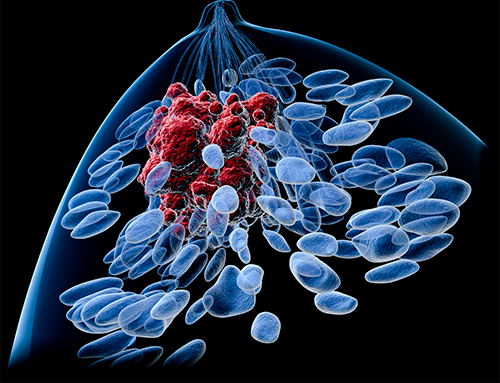Researchers at the Instituto de Medicina Molecular João Lobo, and at the Spanish National Cancer Research Center (CNIO), have discovered one of the mechanisms leading to luminal breast cancer resistance to targeted CDK4/6 inhibitor therapy, and proposed a therapeutic strategy, which uses an existing osteoporosis drug to target the RANKL protein that is involved in luminal BC resistance to existing treatments.
Their studies are reported in Cell Reports Medicine, in a paper titled “Co-targeting RANK pathway treats and prevents acquired resistance to CDK4/6 inhibitors in luminal breast cancer.”
Breast cancer (BC) is the most common cancer in women, among which about 70% belong to the luminal subtype, characterized by expression of the estrogen receptor (ER) and/or progesterone receptor (PR). In fact, these tumors form when estrogen and progesterone instruct the cells to divide. “Although these patients have the better prognosis at early stages, the prognosis is dismal in advanced disease (four-year survival rate 35.9%), accounting for 10% of all deaths of cancer among women in the United States,” commented the authors, led by Luís Costa, PhD, and Sandra Casimiro, PhD at the Instituto de Medicina Molecular João Lobo Antunes (iMM, Portugal) and Eva González Suárez, PhD, at the CNIO.
The usual treatment for advanced cases of ER+HER2- breast cancer is surgery, followed by hormone therapy, alone or in combination with chemotherapy or targeted therapy. Targeted therapies target specific molecules in the tumor. In luminal breast cancer, targeted therapy inhibits CDK4/6 proteins, which control the growth rate and division of cells. The approval of these inhibitors was a breakthrough in the treatment of luminal breast cancer.
“Currently, the first-line standard-of-care treatment for advanced ER+HER2- BC is the combination of endocrine therapy (ET) with cyclin-dependent kinase 4/6 inhibitors (CDK4/6i), which remarkably improved outcomes in this setting,” the researchers continued. However, about 20% of patients do not respond to treatment, while most of those who do respond initially develop resistance within the first two years, which diminishes the effects of the therapy. “Therefore, strategies to predict and overcome intrinsic resistance to CDK4/6i, or to extend benefit by delaying acquired resistance, are a clear unmet need.”
Over the past decade, the RANK pathway—RANK is known to be involved in cell renewal in bones—has emerged as an important mediator of breast morphogenesis and carcinogenesis, but mostly associated with triple-negative BC aggressiveness. The investigators had also previously found that “ … RANK overexpression (OE) mediates an aggressive luminal BC phenotype, with decreased proliferation rate and susceptibility to chemotherapy and ET.” González Suárez, chief of the transformation and metastasis group, added, “Previous research by our group and other authors had already shown that RANK also plays a role in breast cancer, both in tumor initiation and progression.”
Based on their previous findings, the team wanted to investigate whether the RANK pathway might be involved in luminal BC resistance to CDK4/6i. In their newly reported study, the IMM and CNIO researchers showed that high levels of RANK in tumor cells promote resistance to CDK4/6 inhibitors. Their studies in cells, and in mouse xenografts, showed that RANK overexpression in luminal BC was associated with intrinsic resistance to CDK4/6i, and that this was associated with decreased proliferation rate and aberrant interferon (IFN) response in tumor cells. “In this study, sensitive patients in the NeoMONARCH trial had an increase in IFN response after treatment, identical to our findings in cell lines and mouse tumors,” they wrote.
So patients with high levels of RANK protein are not only left without a natural defense of their bodies, but also cease to respond over time to the more common and effective treatment. Moreover, the investigators wrote, “Gene expression data from the NeoPalAna CDK4/6i clinical trial, and studies with palbociclib-resistant cell lines, show that RANK is upregulated after treatment with CDK4/6i, supporting a role in acquired resistance.”
These results have clinical value. A patient’s RANK levels could potentially help decide if inhibitors of CDK4/6 would be a treatment option. Also, further research could be carried out towards complementing combined hormone and targeted therapy with a third drug aimed to block the action of RANK and overcome resistance.
In their study, the researchers suggest that RANK ligand (RANKL) inhibitors might be used in combination therapy against luminal breast cancer. In vitro tests with different RANKL inhibitors confirmed that treatment restored sensitivity to CDK4/6i, and prevented the onset of acquired resistance.
The researchers propose a potential clinical application for the RANKL inhibitor, denosumab, a monoclonal antibody approved in the United States and Europe to treat osteoporosis and prevent metastasis to the bones and skeletal damage from other cancers. As a fully human antibody, denosumab couldn’t be tested in the researchers’ newly reported murine studies.
González Suárez remarked: “Its advantage is that, because it is already approved, we know a lot about its safety profile. We are aware of its potential side effects, which can be considered as minor in a cancer context. Therefore, from a research perspective, a clinical trial with patients could be designed at once … This is the obvious move. For the paper, we have worked only with cell lines and mice models without an immune system, which is very important. The clinical trials with patients would confirm whether there is a real benefit from adding denosumab to the combined hormone and CDK4/6 inhibitors therapy.”
Noting limitations of their reported study, the authors concluded, “Our study shows that RANKL inhibitors can restore sensitivity to CDK4/6i and prevent acquired resistance. On the basis of these findings, we conclude that pharmacological inhibition of the RANK pathway through RANKL blocking could represent an add-on to ET + CDK4/6i, warranting further clinical studies.”


